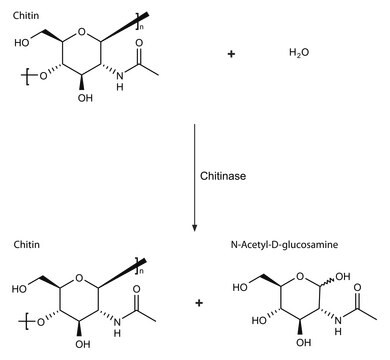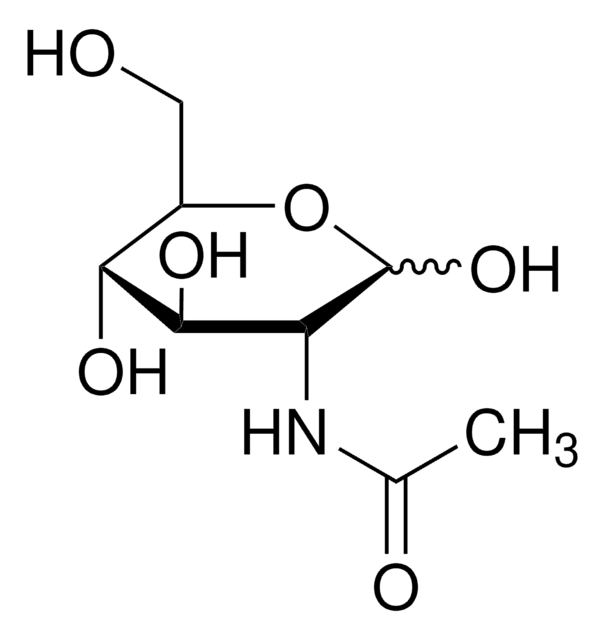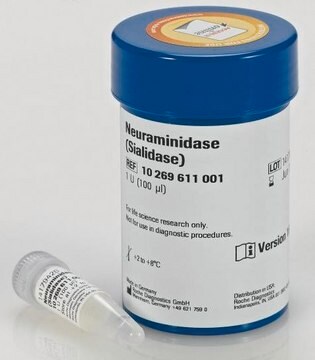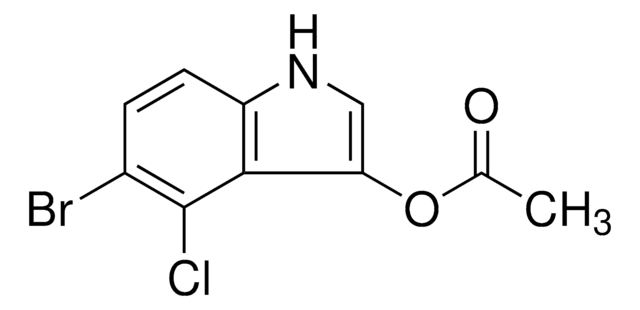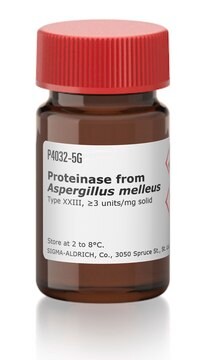추천 제품
애플리케이션
β -N-acetylglucosaminidase is a lysosomal enzyme used to hydrolyze N-acetyl-β-D-glucosaminides and N-acetyl-β-Dgalactosaminides. It is used in chemoenzymatic synthesis of oligosaccharides based on their effective transglycosylation of β-GlcNAc and β-GalNAcc. It may be a useful tool to study Alzheimer′s Disease . Acetylglucosaminidase from Canavalia ensiformis has been used to study enzymic detachment of biofilms .
생화학적/생리학적 작용
This enzyme, sometimes called β-N-acetylhexosaminidase, is reported to liberate terminal β-linked N-acetylglucosamine and N-acetylgalactosamine from a variety of substrates.
This enzyme, sometimes called β-N-acetylhexosaminidase, is reported to liberate terminal β-linked N-acetylglucosamine and N-acetylgalactosamine from a variety of substrates. The activity of β-N-actylglucosaminidase may be determined with the chromogenic substrate p-nitrophenyl-N-acetyl-β-D-glucosaminide. β-N-actylglucosaminidase hydrolyzes the terminal nonreducing N-acetyl-D-hexosamine residues. This enzyme contains two predominant isozymes, Hex A, a heterodimer, and Hex B, a homodimer. N-acetylglucosamine, acetamide, N-2-acetamido-2-deoyglucosylamine, N-acetylnojirimycin, and N-acetyldeoxynojirmycin are known inhibitors.
단위 정의
One unit will hydrolyze 1.0 μmole of p-nitrophenyl N-acetyl-β-D-glucosaminide to p-nitrophenol and N-acetyl-D-glucosamine per min at pH 5.0 at 25 °C.
물리적 형태
Suspension in 2.5 M (NH4)2SO4, pH 7.0
분석 메모
At pH 4.0, p-nitrophenyl β-N-acetylgalactosaminide is hydrolyzed at approximately 50% of the rate of hydrolysis of p-nitrophenyl β-N-acetylglucosaminide at pH 5.0.
Storage Class Code
12 - Non Combustible Liquids
WGK
WGK 3
Flash Point (°F)
Not applicable
Flash Point (°C)
Not applicable
이미 열람한 고객
Mohammed A Al-Fattani et al.
Journal of medical microbiology, 55(Pt 8), 999-1008 (2006-07-20)
Matrix material was extracted from biofilms of Candida albicans and Candida tropicalis and analysed chemically. Both preparations contained carbohydrate, protein, hexosamine, phosphorus and uronic acid. However, the major component in C. albicans matrix was glucose (32%), whereas in C. tropicalis
Chaeyoung Kim et al.
Neurobiology of aging, 34(1), 275-285 (2012-04-17)
Deposition of β-amyloid (Aβ) as senile plaques and disrupted glucose metabolism are two main characteristics of Alzheimer's disease (AD). It is unknown, however, how these two processes are related in AD. Here we examined the relationship between O-GlcNAcylation, which is
Douglas N Sanders et al.
Molecular genetics and metabolism, 108(1), 70-75 (2012-12-26)
GM2 gangliosidosis is a fatal lysosomal storage disease caused by a deficiency of β-hexosaminidase (EC 3.2.1.52). There are two major isoforms of the enzyme: hexosaminidase A composed of an α and a β subunit (encoded by HEXA and HEXB genes
Federica Vernuccio et al.
Recenti progressi in medicina, 103(12), 559-563 (2012-12-22)
Cardiorenal syndrome is a pathophysiological heart and kidney disorder, in which acute or chronic dysfunction of one organ induces a damage in the other. It's a syndrome more and more often encountered in clinical practice and this implies the need
Tyler Mark Pierson et al.
Molecular genetics and metabolism, 108(1), 65-69 (2012-11-20)
A 12 year-old female presented with a seven-year history of progressive muscle weakness, atrophy, tremor and fasciculations. Cognition was normal. Rectal biopsy revealed intracellular storage material and biochemical testing indicated low hexosaminidase activity consistent with juvenile-onset G(M2)-gangliosidosis. Genetic evaluation revealed
문서
Instructions for working with enzymes supplied as ammonium sulfate suspensions
자사의 과학자팀은 생명 과학, 재료 과학, 화학 합성, 크로마토그래피, 분석 및 기타 많은 영역을 포함한 모든 과학 분야에 경험이 있습니다..
고객지원팀으로 연락바랍니다.


